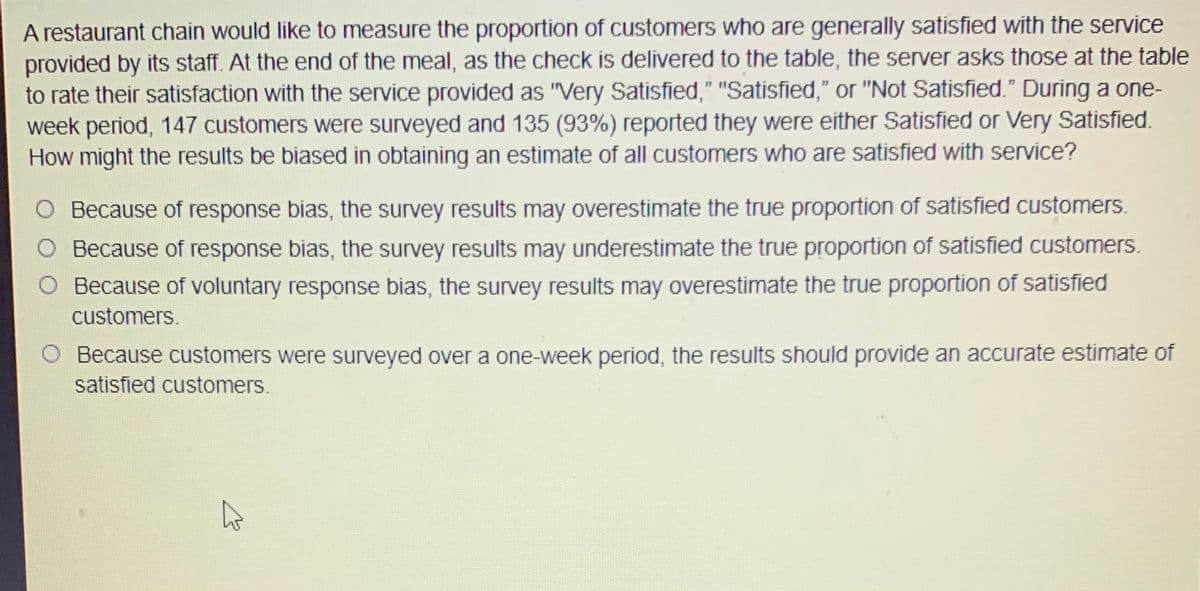A restaurant chain would like to measure the proportion of customers who are generally satisfied with the service provided by its staff. At the end of the meal, as the check is delivered to the table, the server asks those at the table to rate their satisfaction with the service provided as "Very Satisfied," "Satisfied," or "Not Satisfied." During a one- week period, 147 customers were surveyed and 135 (93%) reported they were either Satisfied or Very Satisfied. How might the results be biased in obtaining an estimate of all customers who are satisfied with service? O Because of response bias, the survey results may overestimate the true proportion of satisfied customers. O Because of response bias, the survey results may underestimate the true proportion of satisfied customers. O Because of voluntary response bias, the survey results may overestimate the true proportion of satisfied customers. O Because customers were surveyed over a one-week period, the results should provide an accurate estimate of satisfied customers.
A restaurant chain would like to measure the proportion of customers who are generally satisfied with the service provided by its staff. At the end of the meal, as the check is delivered to the table, the server asks those at the table to rate their satisfaction with the service provided as "Very Satisfied," "Satisfied," or "Not Satisfied." During a one- week period, 147 customers were surveyed and 135 (93%) reported they were either Satisfied or Very Satisfied. How might the results be biased in obtaining an estimate of all customers who are satisfied with service? O Because of response bias, the survey results may overestimate the true proportion of satisfied customers. O Because of response bias, the survey results may underestimate the true proportion of satisfied customers. O Because of voluntary response bias, the survey results may overestimate the true proportion of satisfied customers. O Because customers were surveyed over a one-week period, the results should provide an accurate estimate of satisfied customers.
Glencoe Algebra 1, Student Edition, 9780079039897, 0079039898, 2018
18th Edition
ISBN:9780079039897
Author:Carter
Publisher:Carter
Chapter10: Statistics
Section10.6: Summarizing Categorical Data
Problem 30PPS
Related questions
Topic Video
Question

Transcribed Image Text:A restaurant chain would like to measure the proportion of customers who are generally satisfied with the service
provided by its staff. At the end of the meal, as the check is delivered to the table, the server asks those at the table
to rate their satisfaction with the service provided as "Very Satisfied," "Satisfied," or "Not Satisfied." During a one-
week period, 147 customers were surveyed and 135 (93%) reported they were either Satisfied or Very Satisfied.
How might the results be biased in obtaining an estimate of all customers who are satisfied with service?
O Because of response bias, the survey results may overestimate the true proportion of satisfied customers.
O Because of response bias, the survey results may underestimate the true proportion of satisfied customers.
O Because of voluntary response bias, the survey results may overestimate the true proportion of satisfied
customers.
O Because customers were surveyed over a one-week period, the results should provide an accurate estimate of
satisfied customers.
Expert Solution
This question has been solved!
Explore an expertly crafted, step-by-step solution for a thorough understanding of key concepts.
This is a popular solution!
Trending now
This is a popular solution!
Step by step
Solved in 2 steps

Knowledge Booster
Learn more about
Need a deep-dive on the concept behind this application? Look no further. Learn more about this topic, statistics and related others by exploring similar questions and additional content below.Recommended textbooks for you

Glencoe Algebra 1, Student Edition, 9780079039897…
Algebra
ISBN:
9780079039897
Author:
Carter
Publisher:
McGraw Hill

College Algebra (MindTap Course List)
Algebra
ISBN:
9781305652231
Author:
R. David Gustafson, Jeff Hughes
Publisher:
Cengage Learning

Glencoe Algebra 1, Student Edition, 9780079039897…
Algebra
ISBN:
9780079039897
Author:
Carter
Publisher:
McGraw Hill

College Algebra (MindTap Course List)
Algebra
ISBN:
9781305652231
Author:
R. David Gustafson, Jeff Hughes
Publisher:
Cengage Learning